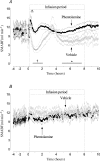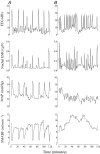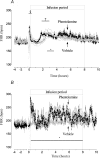The role of the sympathetic nervous system in postasphyxial intestinal hypoperfusion in the pre-term sheep fetus
- PMID: 15073276
- PMCID: PMC1665158
- DOI: 10.1113/jphysiol.2004.062554
The role of the sympathetic nervous system in postasphyxial intestinal hypoperfusion in the pre-term sheep fetus
Abstract
Asphyxia in utero in pre-term fetuses is associated with evolving hypoperfusion of the gut after the insult. We examined the role of the sympathetic nervous system (SNS) in mediating this secondary hypoperfusion. Gut blood flow changes were also assessed during postasphyxial seizures. Preterm fetal sheep at 70% of gestation (103-104 days, term is 147 days) underwent sham asphyxia or asphyxia induced by 25 min of complete cord occlusion and fetuses were studied for 3 days afterwards. Phentolamine (10 mg bolus plus 10 mg h(-1)i.v.) or saline was infused for 8 h starting 15 min after the end of asphyxia or sham asphyxia. Phentolamine blocked the fall in superior mesenteric artery blood flow (SMABF) after asphyxia and there was a significant decrease in MAP for the first 3 h of infusion (33 +/- 1.6 mmHg versus vehicle 36.7 +/- 0.8 mmHg, P < 0.005). During seizures SMABF fell significantly (8.3 +/- 2.3 versus 11.4 +/- 2.7 ml min(-1), P < 0.005), and SMABF was more than 10% below baseline for 13.0 +/- 1.7 min per seizure (versus seizure duration of 78.1 +/- 7.2 s). Phentolamine was associated with earlier onset of seizures (5.0 +/- 0.4 versus 7.1 +/- 0.7 h, P < 0.05), but no change in amplitude or duration, and prevented the fall in SMABF. In conclusion, the present study confirms the hypothesis that postasphyxial hypoperfusion of the gut is strongly mediated by the SNS. The data highlight the importance of sympathetic activity in the initial elevation of blood pressure after asphyxia and are consistent with a role for the mesenteric system as a key resistance bed that helps to maintain perfusion in other, more vulnerable systems.
Figures




References
-
- Akinbi H, Abbasi S, Hilpert PL, Bhutani VK. Gastrointestinal and renal blood flow velocity profile in neonates with birth asphyxia. J Pediatr. 1994;125:625–627. - PubMed
-
- Barlow RM. The foetal sheep: morphogenesis of the nervous system and histochemical aspects of myelination. J Comp Neurol. 1969;135:249–262. - PubMed
-
- Baumgartner C, Lurger S, Leutmezer F. Autonomic symptoms during epileptic seizures. Epileptic Disord. 2001;3:103–116. - PubMed
-
- Bennet L, Quaedackers JS, Gunn AJ, Rossenrode S, Heineman E. The effect of asphyxia on superior mesenteric artery blood flow in the premature sheep fetus. J Pediatr Surg. 2000;35:34–40. - PubMed
Publication types
MeSH terms
Substances
Grants and funding
LinkOut - more resources
Full Text Sources
Miscellaneous

